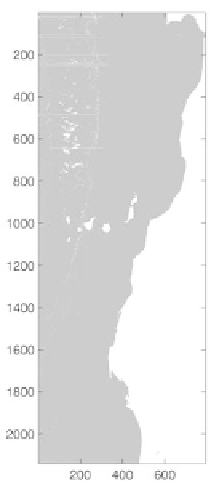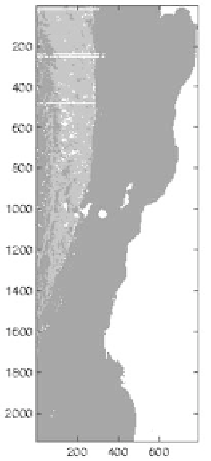Information Technology Reference
In-Depth Information
Fig. 7.30.
Presentation of the two classes that are proposed by PRSOM + BUHC:
the
left
image is representing the original SeaWifs image the
center
image represents
the land mask that is provided by SeaWifs (in
white
on the image) and the
right
image presents the binary classification that is provided by PRSOM + BUHC (the
light zone is similar to the class 2 of Fig. 7.29 and represent thick clouds, the dark
zone includes various aerosols); PRSOM was achieved using App
cod1
as learning set
and BUHC uses the Ward index
clustered at the level 35 of the hierarchy. Thus, it is possible to propose from
this result a classifier that enables to automatically identify the case 2 water
labeled pixels. The neurons 33, 82 and 93 will be labeled case 2, all the other
neurons will be labeled by a negative label that points out they do not belong
to case 2. Then, it appears that in that case, using the hierarchical clustering
without additional expert knowledge may allow retrieving information which
comes from the physics of measure.
The last experiment is using straight expert knowledge. Knowledge is used
to label neurons according to the methodology that was presented previously
in the section about classification and topology. The test set is the expert-
labeled GAC image. Each neuron is then mastering pixels of GAC image that
are allocated to that neuron. These pixels constitute a subset of labeled ele-
ments. The label of the associate neuron is determined by a majority voting.
The two classifications are compared on Table 7.3 where the confusion ma-
trix is represented. It is clear that the neurons correctly provide the expert
knowledge.



Search WWH ::

Custom Search